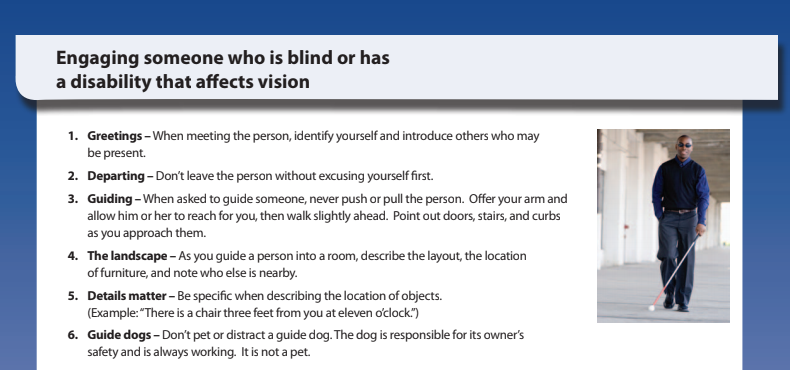
by April Meredith, Empower Tennessee Independent Living and Advocacy Specialist
Have you ever hosted a party or had company over to your place for dinner? You may have started with some planning questions. When will it be? Who will be invited? What should we eat? Will food be cooked or catered? Then, as those questions were answered, you probably moved on to planning more specific aspects of the gathering such as eating utensils, seating, music selection, and additional activities – all based on the needs and preferences of each particular guest.
The same kind of deliberate consideration should be used when working with employees who have disabilities. For example, if you are handing out agendas at a meeting, would you only prepare copies for attendees who are 5’8” or shorter, and then apologize to those who happened to be taller? That may seem ridiculous, but it is no different than the times I have participated in meetings where only standard print copies of materials were available and no alternative formats were provided for participants with low-vision such as myself. A simple call for accommodation requests at a reasonable time before holding the meeting could have ensured the information being shared was accessible for all. As an employee with a disability, I do have a responsibility to speak up for myself. However, the most productive and mutually beneficial professional relationships are those where both parties actively strive to understand each other. Colleagues who are willing to learn about me and my disability are more likely to lay a strong foundation for a healthy working collaboration.
Fortunately, there is a resource specifically designed to assist you in getting to know people with disabilities. The Tennessee Disability Coalition’s Disability Etiquette Brochure includes excellent tips for engaging someone who is blind or has a disability that affects vision.
The brochure encourages you to identify yourself and introduce others who may be present when greeting a person who is blind or has limited eyesight. This is very important to me as it is challenging to recognize an individual solely based on their voice. It’s also quite embarrassing to have to ask who I’m speaking to. Avoid the guessing game and uneasiness by stating your name up front. That way, we can focus on the conversation and pleasantries. I highly recommend taking some time to review the suggestions this brochure contains. Never hesitate to ask someone with a disability if you have questions or concerns on how to engage with us respectfully. Referring to this useful resource may empower you as employers, coworkers, and community partners to have positive, successful interactions with individuals who are blind or visually-impaired or have other disabilities. I have experienced first-hand that people who are knowledgeable about my needs and preferences have more comfortable and effective exchanges with me.
Whether it be during a meeting, in an office, at a conference, in the community, or online, disability etiquette should be in the forefront of how you approach creating a welcoming, inclusive environment. Lack of understanding can lead to awkwardness and miscommunication. Empathy and awareness can break down barriers and aid in fostering positive professional relationships with all workers who have disabilities.
![]()